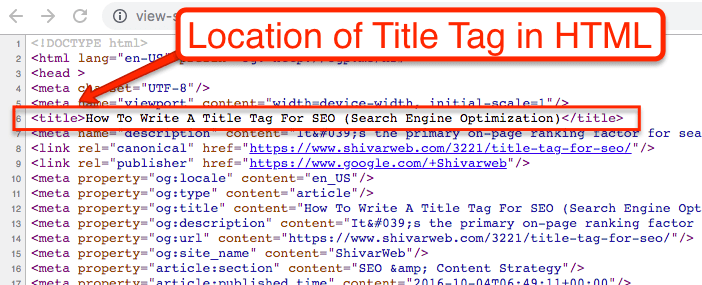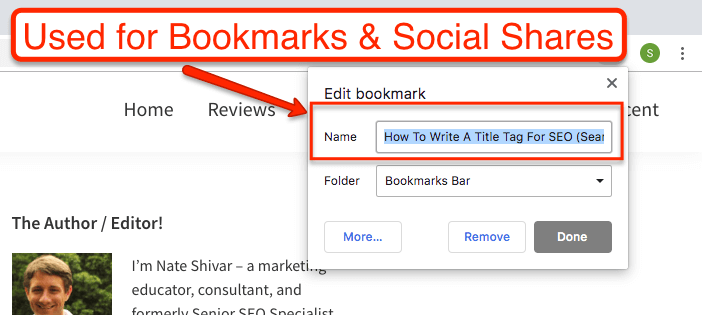Writing an effective title tag for SEO & branding should be the first on-page SEO website improvement you make after you map your site’s keywords.
The humble title tag is still the primary element on your site that search engines use to understand the content of a page. The title tag is also the element from your website that actually shows up in search results & your customers’ bookmarks & social posts by default. It’s what your potential visitors click on to navigate to your site.
And yet, writing a custom title tag for SEO is all too often ignored, skipped over, or not given enough time.
There’s no formula to writing a title tag for SEO – but there are plenty of parameters and best practices. Here’s how you can craft an effective title tag to explain your relevance to the Googlebot while still enticing clicks from potential customers.
Understand What The Title Tag Is
The title tag of a page is literally its web page title. But, depending on your website setup – it can be a bit confusing exactly what you are looking to change.
You are specifically looking for the text that appears between the <title></title> in the HTML of the webpage. First, Right Click anywhere on your page, then “View Source in Browser”.

In some website setups, it might be called the “SEO title” or “Browser title.”
It doesn’t appear on the viewable page in web browsers. It does make an appearance somewhere on the top of the open tab in various browsers.

It will also make an appearance wherever that page’s link is saved – such as a bookmark or a social network share.

So while it is not explicitly seen in the content of a page, it is not something “only seen by search engines.” If you spam it with keywords – users will see it in some way.
And there’s one last very important place it will often be seen.

Search engines more often than not will use the title tag of the relevant webpage in the search results. Your title tag text is what users actually click on to come to your site via search engines.
So even beyond SEO, writing a solid title tag might be worth considering. But writing a title tag for SEO is especially important since test after test for years and years in the SEO industry has indicated that the title tag is the single most important element on your webpage for search engines.
To take a step back, when a search engine bot shows up on a webpage, it is processing dozens (if not hundreds) of signals to try to figure out what a page is about – and what search queries it would be relevant for.
Search engines use the title tag as one signal among many to understand what a page is about. The goal of writing a title tag for SEO is to make a page’s relevance as obvious and as easily understood as possible.
For example, ‘Services’ as a title tag is simply not very descriptive or helpful for a bot trying to understand a page. That page could be for any company in any industry. The bot has to go and use other signals to decipher what a page is about.
However, if that same page’s title tag was Plumbing Services: Residential & Commercial Plumbing – the bot would have a pretty solid idea about what that services page is about. A page that is completely understood by search engines is more likely to rank for relevant terms than a page less understood, but maybe just as relevant (to humans).
Long Enough To Be Useful, Short Enough To Be Seen
Your page’s title tag should be 50 to 70 characters long – that’s industry best practice. Why?
That’s how many characters Google will display in its search results. Anything longer will be truncated and invisible to searchers.
NB: Technically, Google truncates after a certain number of pixels. So if you’re title tag is a bunch of l’s and i’s – then you will be able to show more than 70 characters. But on average, the rule remains at 70 characters.
For anyone who has been in the SEO industry for a while – this best practice has been fluctuating for a few years.
For years and years, 69 to 70 characters was best practice (or 512 pixels). Then in 2014, Google increased their default font size so that optimum length for title tags was between 55 and 60 characters. But then in May 2016, Google increased the width of their SERPs returning the best practice to 60 to 70.
70 characters isn’t a lot of real estate to describe your page – but if you spend a bit of time being creative, you’ll find that the Art of The Title Tag can be a useful exercise (I think of it as a really nerdy form of haiku).
Again, 70 characters is only best practice – it’s not a rule set in stone. If 75 characters would be more descriptive, then write 75. If anything more than 50 would look spammy – then don’t write more than 50.
Make it long enough to be useful for search engines, but short enough to be seen and used by searchers.
Title tags less than 50 tend to not be descriptive. Anything pushing 80+ characters really starts to look desperate and targeted to search engines (which search engines don’t like).
This brings up one last point about length – if Google doesn’t think your title tag is useful, they will simply ignore it and use whatever Google thinks is appropriate.
If you are using WordPress to power your site, then you should be using Yoast SEO plugin, which has a built-in character counter.
Otherwise, I typically use the LEN function in Excel or this handy character counter to keep track of length or Moz’s title tag tool to generate a quick preview.
Integrate Your Target Keywords
I’ve outlined how to map your keywords, do keyword research, and judge keyword difficulty previously. Now, you get to actually apply your keywords on your site, starting with the title tag.
As consistent tests have shown, it is important to keep your keywords first in your title tags. Refer to your keyword theme that you have mapped to each page, and try to write a description of each page in a sentence form that integrates your priority keywords. There is no formula for writing a good title tag, but here are a few tips:
- Avoid pipes | – they are now seen as a bit spammy, and not user-friendly (but you can break this rule of course)
- Google wants to see a natural title that works for humans (structured like a sentence)
- Start with your highest-priority keyword…unless it would prevent a natural sentence
- Add or subtract your brand depending on available characters
- Colons and ampersands are your friend
- Good grammar and capitalization are your friend
- Repeating a word can be good…unless it looks spammy and not useful for humans
- For content, experiment with calls to action surrounding the main keyword instead of using more keywords
If you have mapped your keywords into a solid theme, you’ll often find that your secondary keywords are types of your high priority keyword. This isn’t a formula, but you may often see something like:
Keyword 1: Keyword 2 & Keyword 3 at Brand Name
Atlanta Plumbing: Residential & Commercial Plumbing by Unclogged Inc. (and yes, that is 69 characters).
Notice how it’s starts with a big topic keyword, followed by sub-topic keywords and the brand.
There are an infinite number of ways to write a title tag for SEO – but that’s a typical example. The goal is to describe the page for your users and search engines with target keywords mapped to the page.
Keep It Unique & Organized
It’s easy to take shortcuts when writing title tags for your website, but keep in mind that unique, descriptive content is what search engines value, and what will put you ahead of your competition.
Google will even call out in Search Console if you have duplicate title tags.
To keep everything organized and consistent, I recommend keeping your title tags written out in your keyword map.
Just make an additional column – and write them directly in Excel/Google Sheets. It will help you go faster (with your keywords written in the same spreadsheet) and keep things differentiated and easily referenced.
Write For Your Customer
The last step is quality assurance. Go back and read each of your title tags aloud (tip from Brett Snyder who you should be following on Twitter and listening to on our podcast).
Does it sound odd? Does it sound descriptive? Is it something you would click on?
If so, then implement it on your site, and analyze the results.
Lastly, keep in mind that your title tag is never set in stone. If search engines or customers don’t respond well to it, then change it! If you have a low-priority page with steady traffic – use it to experiment. Test, analyze, and change.
Bonus: If you want to really dive deep, enjoy this video tutorial by Cyrus Shepard of Moz.
Next Steps
Check out the podcast episode on Beginner SEO Tips.
Check out my guide to Yoast & also Search Console and Keyword Planner.
Read more about finding pre-qualified content ideas for SEO.
Complementary advanced post on title tags from Siege Media and Ahrefs.
Related Articles
- How to Build a Minimally Viable Website
- 404 Page Best Practices, Ideas, & Examples
- Contact Us Page Best Practices, Ideas & Examples
- Ecommerce Product Page Best Practices, Ideas, & Examples
- Effective About Us Page Design: Best Practices & Examples
- FAQ Page Best Practices, Ideas & Examples
- Homepage Best Practices, Ideas, & Examples
- How To Design a Website Layout w/ Best Practices & Examples
- Thank You Page Best Practices, Ideas & Examples
- What Is A Web Design Color Palette and How Do I Make One?
- How Much Is A Website Per Year Explained
- 59+ Ways To Find Free Images For Commercial Use
- How to Improve Your Website Content
- How To Write A Meta Description For SEO
- Website Design Best Practices w/ Examples
- Landing Page Best Practices w/ Ideas & Examples




Thank you for a great article on Title Tags. I appreciate your clarity and explanation. You recommend against using pipes. Would you then structure the Title tag for a blog post like this:
How Contractors Can Use Testimonials In Their Marketing
instead of like this:
Contractors | Testimonials | Marketing
Thanks again for the article – from a fellow Atlantan.
Thanks Ajmer!